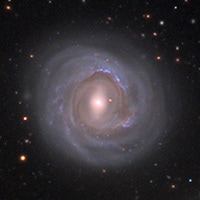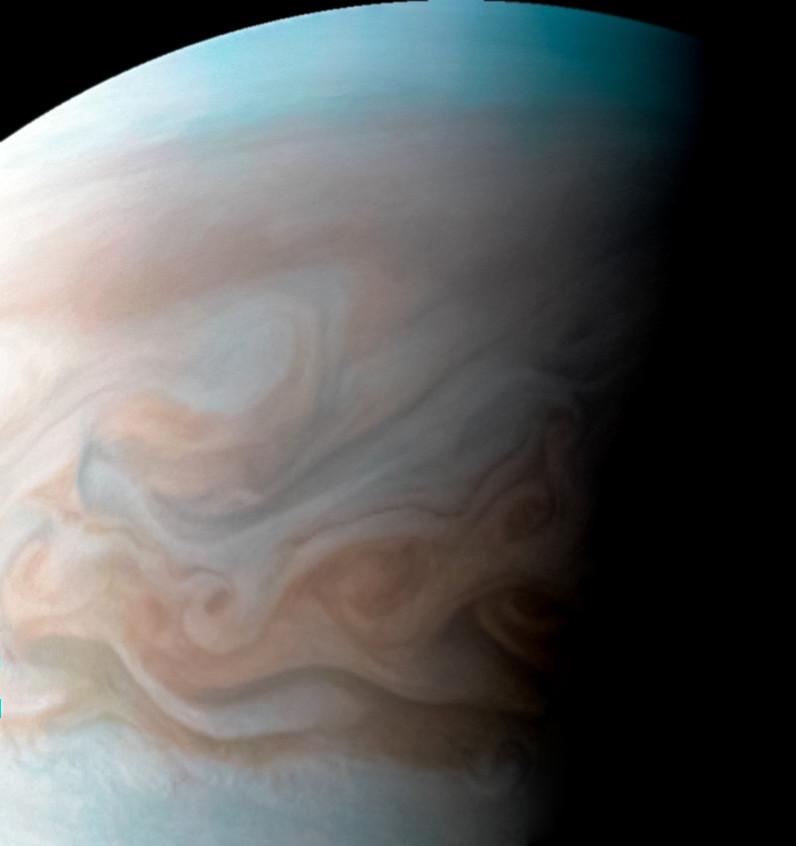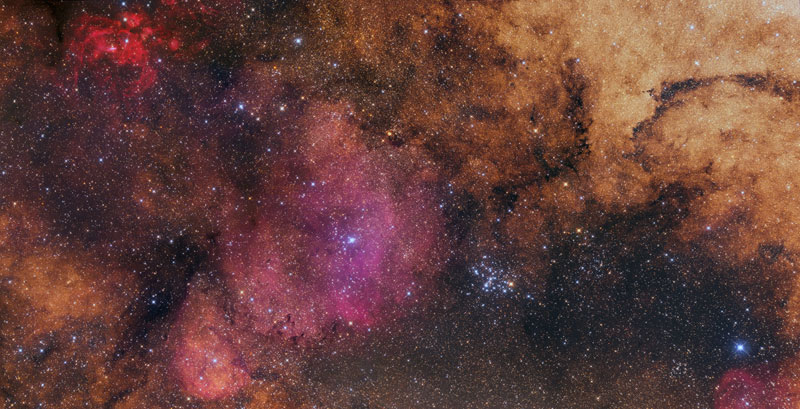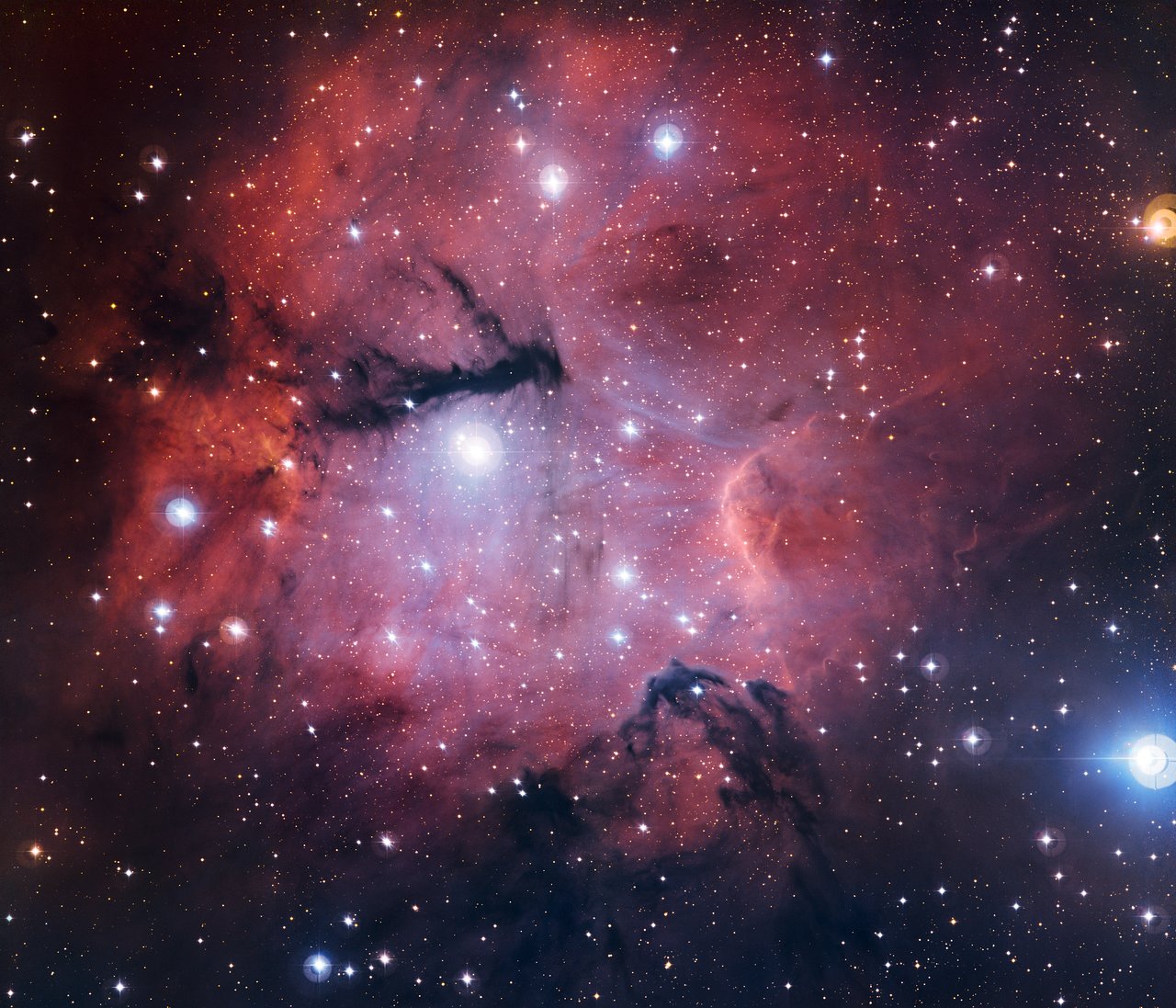Found images: 2017 March
Found images: 2017 March
Have you seen a great image or video somewhere that you think would make a great APOD? Nominate it for APOD! Please post as much information here as you have about the image/video with a link to any source(s) for it you know of here, and the editors will take a look.
When posting the image itself, please do not post anything larger than a thumbnail here; please honor the copyright holder's copyright.
Please keep hotlinked images under 400K.
Thank you!
<< Previously
SwRI: Juno Captures Jupiter Cloudscape in High Resolution
Juno Captures Jupiter Cloudscape in High Resolution
Southwest Research Institute | NASA | JPL-Caltech | JunoCam | 2017 Mar 01
Southwest Research Institute | NASA | JPL-Caltech | JunoCam | 2017 Mar 01
This close-up view of Jupiter captures the turbulent region just west of the Great Red Spot in the South Equatorial Belt, with resolution better than any previous pictures from Earth or other spacecraft.
NASA’s Juno spacecraft captured this image with its JunoCam citizen science instrument when the spacecraft was a mere 5,400 miles (8,700 kilometers) above Jupiter’s cloudtops on Dec. 11, 2016 at 9:14 a.m. PT (12:14 p.m. ET). Citizen scientist Sergey Dushkin produced the sublime color processing and cropped the image to draw viewers’ eyes to the dynamic clouds. ...
Know the quiet place within your heart and touch the rainbow of possibility; be
alive to the gentle breeze of communication, and please stop being such a jerk. — Garrison Keillor
alive to the gentle breeze of communication, and please stop being such a jerk. — Garrison Keillor
-
starsurfer
- Stellar Cartographer
- Posts: 5330
- Joined: Thu Mar 15, 2012 7:25 pm
-
starsurfer
- Stellar Cartographer
- Posts: 5330
- Joined: Thu Mar 15, 2012 7:25 pm
Re: Found images: 2017 March
NGC 6852
http://www.chart32.de/index.php/component/k2/item/225
Copyright: CHART32
Processing: Johannes Schedler
http://www.chart32.de/index.php/component/k2/item/225
Copyright: CHART32
Processing: Johannes Schedler
-
starsurfer
- Stellar Cartographer
- Posts: 5330
- Joined: Thu Mar 15, 2012 7:25 pm
-
starsurfer
- Stellar Cartographer
- Posts: 5330
- Joined: Thu Mar 15, 2012 7:25 pm
Re: Found images: 2017 March
IPHASX J195744.9+305306 and Sh2-98
http://outters.fr/wp/sh2-98-hoo-rvb/
Copyright: Nicolas Outters http://outters.fr/wp/sh2-98-sho/
http://outters.fr/wp/sh2-98-hoo-rvb/
Copyright: Nicolas Outters http://outters.fr/wp/sh2-98-sho/
-
starsurfer
- Stellar Cartographer
- Posts: 5330
- Joined: Thu Mar 15, 2012 7:25 pm
Re: Found images: 2017 March
Atoms for Peace Galaxy (NGC 7252)
http://spacetelescope.org/images/potw1549a/
Copyright: NASA & ESA
Acknowledgements: Judy Schmidt
http://spacetelescope.org/images/potw1549a/
Copyright: NASA & ESA
Acknowledgements: Judy Schmidt
Re: Found images: 2017 March
NGC 4921
Copyright: Adam Block
 NGC 4921 is a spiral galaxy on the outskirts of the massive Coma Cluster, which is heavily dominated by "red and dead" ellipticals. The Coma Cluster is just the the sort of place where galaxies are "harassed" into giving up star formation. Star formation in NGC 4921 is indeed winding down, but still it is giving birth to a few new blue stars. It has been called a gossamer galaxy.
NGC 4921 is a spiral galaxy on the outskirts of the massive Coma Cluster, which is heavily dominated by "red and dead" ellipticals. The Coma Cluster is just the the sort of place where galaxies are "harassed" into giving up star formation. Star formation in NGC 4921 is indeed winding down, but still it is giving birth to a few new blue stars. It has been called a gossamer galaxy.
Full size here.
Ann
Copyright: Adam Block

Full size here.
Ann
Color Commentator
Re: Found images: 2017 March
NGC 128
Copyright: Adam Block
 The large edge-on galaxy is NGC 128, even though it is being called NGC 125 on the Caelum Observatory galaxy gallery page.
The large edge-on galaxy is NGC 128, even though it is being called NGC 125 on the Caelum Observatory galaxy gallery page.
NGC 128 has an enormous peanut-shaped bulge. This is usually interpreted as the sign of (in this case, an enormous) bar.
NGC 127 to the right appears to possibly be undergoing a central starburst.
Full size here.
Ann
Copyright: Adam Block

NGC 128 has an enormous peanut-shaped bulge. This is usually interpreted as the sign of (in this case, an enormous) bar.
NGC 127 to the right appears to possibly be undergoing a central starburst.
Full size here.
Ann
Color Commentator
-
starsurfer
- Stellar Cartographer
- Posts: 5330
- Joined: Thu Mar 15, 2012 7:25 pm
Re: Found images: 2017 March
In the full frame image, NGC 125 is the spiral galaxy to the south with the large tidal loop. Adam Block is amazing!Ann wrote:NGC 128
Copyright: Adam Block
The large edge-on galaxy is NGC 128, even though it is being called NGC 125 on the Caelum Observatory galaxy gallery page.
NGC 128 has an enormous peanut-shaped bulge. This is usually interpreted as the sign of (in this case, an enormous) bar.
NGC 127 to the right appears to possibly be undergoing a central starburst.
Full size here.
Ann
-
starsurfer
- Stellar Cartographer
- Posts: 5330
- Joined: Thu Mar 15, 2012 7:25 pm
Re: Found images: 2017 March
Orion Nebula (M42) region
http://www.karelteuwen.be/photo_page.ph ... 3&album=15
Copyright: Karel Teuwen To the north of M42 is the Running Man Nebula (NGC 1973-5-7), above this is the open cluster NGC 1981. Other nebulae include NGC 1999 to the south of M42 while the small reflection nebula to the right of M42 is vdB42. Finally IC 420 can be seen to the right of NGC 1981.
http://www.karelteuwen.be/photo_page.ph ... 3&album=15
Copyright: Karel Teuwen To the north of M42 is the Running Man Nebula (NGC 1973-5-7), above this is the open cluster NGC 1981. Other nebulae include NGC 1999 to the south of M42 while the small reflection nebula to the right of M42 is vdB42. Finally IC 420 can be seen to the right of NGC 1981.
ESO: Celestial Spiral with a Twist (LL Pegasi)
Celestial Spiral with a Twist
ESO Picture of the Week | 2017 Mar 06
http://asterisk.apod.com/viewtopic.php?t=36924
ESO Picture of the Week | 2017 Mar 06
[c][imghover=https://cdn.eso.org/images/screen/potw1710b.jpg]https://cdn.eso.org/images/screen/potw1710a.jpg[/imghover]ALMA and Hubble observe LL PegasiAlthough it looks like the pattern of a shell on the beach, this intriguing spiral is in fact astronomical in nature. The Atacama Large Millimeter/submillimeter Array (ALMA) captured this remarkable image of a binary star system, where two stars — LL Pegasi and its companion — are locked in a stellar waltz, orbiting around their common centre of gravity. The old star LL Pegasi is continuously losing gaseous material as it evolves into a planetary nebula, and the distinct spiral shape is the imprint made by the stars orbiting in this gas.
Credit: ALMA (ESO/NAOJ/NRAO)/H. Kim et al., ESA/NASA & R. Sahai[/c][hr][/hr]
The spiral spans light-years and winds around with extraordinary regularity. Based on the expansion rate of the spiralling gas, astronomers estimate that a new “layer” appears every 800 years — approximately the same time it takes for the two stars to complete one orbit around each other.
LL Pegasi was first highlighted about 10 years ago when the NASA/ESA Hubble Space Telescope obtained a picture of the almost-perfect spiral structure. This was the first time a spiral pattern had been found in material surrounding an old star. Now, ALMA’s observations, of which this image only shows one “cross-section”, have added an extra dimension to reveal the exquisitely-ordered 3D geometry of the spiral pattern. A full view of the 3D video can be seen in this video. ...
http://asterisk.apod.com/viewtopic.php?t=36924
Know the quiet place within your heart and touch the rainbow of possibility; be
alive to the gentle breeze of communication, and please stop being such a jerk. — Garrison Keillor
alive to the gentle breeze of communication, and please stop being such a jerk. — Garrison Keillor
HEIC: Home to a Hypergiant (Westerlund 1)
Home to a Hypergiant
ESA Hubble Picture of the Week | 2017 Mar 06
ESA Hubble Picture of the Week | 2017 Mar 06
[img3="Credit: ESA/Hubble & NASA"]https://cdn.spacetelescope.org/archives ... w1710a.jpg[/img3][hr][/hr]Light travels through space at just under 300 000 kilometres per second! This staggering speed is used to calculate astronomical distances; although often misinterpreted as a unit of time (due to its misleading name), a light-year is actually a unit of astronomical distance, and is defined as the distance that light travels in a year. For reference, this is around nine trillion kilometres… but it’s a little tricky to visualise!
With this in mind, 15 000 light-years may sound like a truly huge distance, but compared to the vastness of the cosmos, it’s really quite nearby. In fact, an object sitting 15 000 light-years away would not even be outside our home galaxy, the Milky Way. This is roughly the distance between us and a young super star cluster known as Westerlund 1, home to one of the largest stars ever discovered.
Stars are classified according to their spectral type, surface temperature, and luminosity. While studying and classifying the cluster’s constituent stars, astronomers discovered that Westerlund 1 is home to one of the largest stars ever discovered, originally named Westerlund 1-26. It is a red supergiant (although sometimes classified as a hypergiant) with a radius over 1500 times that of our Sun. If Westerlund 1-26 were placed where our Sun is in our Solar System, it would extend out beyond the orbit of Jupiter.
Most of Westerlund 1’s stars are thought to have formed in the same burst of activity, meaning that they have similar ages and compositions. The cluster is relatively young in astronomical terms —at around three million years old it is a baby compared to our own Sun, which is some 4.6 billion years old.
Know the quiet place within your heart and touch the rainbow of possibility; be
alive to the gentle breeze of communication, and please stop being such a jerk. — Garrison Keillor
alive to the gentle breeze of communication, and please stop being such a jerk. — Garrison Keillor
Re: HEIC: Home to a Hypergiant (Westerlund 1)
I tried to figure out which star is Westerlund 1-26. I think it is the orange star nestled between blue ones in the part of the cluster which is most dominated by bright stars.bystander wrote:Home to a Hypergiant
ESA Hubble Picture of the Week | 2017 Mar 06[img3="Credit: ESA/Hubble & NASA"]https://cdn.spacetelescope.org/archives ... w1710a.jpg[/img3][hr][/hr]Light travels through space at just under 300 000 kilometres per second! This staggering speed is used to calculate astronomical distances; although often misinterpreted as a unit of time (due to its misleading name), a light-year is actually a unit of astronomical distance, and is defined as the distance that light travels in a year. For reference, this is around nine trillion kilometres… but it’s a little tricky to visualise!
With this in mind, 15 000 light-years may sound like a truly huge distance, but compared to the vastness of the cosmos, it’s really quite nearby. In fact, an object sitting 15 000 light-years away would not even be outside our home galaxy, the Milky Way. This is roughly the distance between us and a young super star cluster known as Westerlund 1, home to one of the largest stars ever discovered.
Stars are classified according to their spectral type, surface temperature, and luminosity. While studying and classifying the cluster’s constituent stars, astronomers discovered that Westerlund 1 is home to one of the largest stars ever discovered, originally named Westerlund 1-26. It is a red supergiant (although sometimes classified as a hypergiant) with a radius over 1500 times that of our Sun. If Westerlund 1-26 were placed where our Sun is in our Solar System, it would extend out beyond the orbit of Jupiter.
Most of Westerlund 1’s stars are thought to have formed in the same burst of activity, meaning that they have similar ages and compositions. The cluster is relatively young in astronomical terms —at around three million years old it is a baby compared to our own Sun, which is some 4.6 billion years old.
Fascinatingly, if that star is Westerlund 1-26, it does not appear to be the brightest star of this remarkable cluster.
Ann
Color Commentator
-
starsurfer
- Stellar Cartographer
- Posts: 5330
- Joined: Thu Mar 15, 2012 7:25 pm
Re: Found images: 2017 March
Butterfly Cluster (M6) region
http://www.astrostudio.at/1_Deep%20Sky% ... a661ff247a
Copyright: Gerald Rhemann The large emission nebula near the centre is RCW 132 and NGC 6357 is the nebula in the top left corner.
http://www.astrostudio.at/1_Deep%20Sky% ... a661ff247a
Copyright: Gerald Rhemann The large emission nebula near the centre is RCW 132 and NGC 6357 is the nebula in the top left corner.
-
starsurfer
- Stellar Cartographer
- Posts: 5330
- Joined: Thu Mar 15, 2012 7:25 pm
-
starsurfer
- Stellar Cartographer
- Posts: 5330
- Joined: Thu Mar 15, 2012 7:25 pm
-
starsurfer
- Stellar Cartographer
- Posts: 5330
- Joined: Thu Mar 15, 2012 7:25 pm
-
starsurfer
- Stellar Cartographer
- Posts: 5330
- Joined: Thu Mar 15, 2012 7:25 pm
-
starsurfer
- Stellar Cartographer
- Posts: 5330
- Joined: Thu Mar 15, 2012 7:25 pm
ESO: ALMA Peers into the Hearts of Stellar Nurseries
ALMA Peers into the Hearts of Stellar Nurseries
ESO Picture of the Week | 2017 Mar 13
ESO Picture of the Week | 2017 Mar 13
[img3="Credit: ALMA (ESO/NAOJ/NRAO)/A. Schruba,With their spectacular glowing arms, grand spiral galaxies seem to get all the attention — but NGC 6822, a barred irregular dwarf galaxy, proves that regular spirals do not have a monopoly on galactic beauty. Also called Barnard’s galaxy, NGC 6822 is located in the constellation of Sagittarius just 1.6 million light-years away and is brimming with rich star formation regions.
VLA (NRAO)/Y. Bagetakos/Little THINGS"]https://cdn.eso.org/images/screen/potw1711a.jpg[/img3][hr][/hr]
This new image is a composite of older observations made with the Wide Field Imager attached to the 2.2-metre MPG/ESO telescope at ESO’s La Silla Observatory and new data collected by the Atacama Large Millimeter/submillimeter Array (ALMA). The areas observed with ALMA are highlighted in the image and can be seen here in detail.
The observations by ALMA reveal the structure of star-forming gas clouds in unprecedented resolution. Observations in our own galaxy have shown that stars form in the dense cores of giant clouds of molecular hydrogen gas, the only places where gas can become cold enough to collapse under its own gravity. These conditions also foster the formation of other molecules, such as carbon monoxide, which are an indispensable tool in helping astronomers to detect galactic molecular hydrogen gas.
Until recently, astronomers have only been able to resolve star formation regions within the Milky Way — but now ALMA’s sharp sight provides a window into star formation in other galaxies. The analysis of the data revealed that, unlike in our own galaxy, the observed molecules are concentrated into small, dense cores of gas. This explains why it has been so hard to observe extragalactic star formation regions so far, especially in low mass, low metallicity galaxies. ALMA also found that the cores in NGC 6822 behave remarkably similarly to stellar nurseries in the Milky Way, indicating that the physics of star formation in these low-mass galaxies resemble that which we see in our own galaxy.
Know the quiet place within your heart and touch the rainbow of possibility; be
alive to the gentle breeze of communication, and please stop being such a jerk. — Garrison Keillor
alive to the gentle breeze of communication, and please stop being such a jerk. — Garrison Keillor
HEIC: Seeing Things Sideways (NGC 1448)
Seeing Things Sideways
ESA Hubble Picture of the Week | 2017 Mar 13
ESA Hubble Picture of the Week | 2017 Mar 13
[img3=""Credit: ESA/Hubble, NASA""]https://cdn.spacetelescope.org/archives ... w1711a.jpg[/img3][hr][/hr]This image from Hubble’s Wide Field Camera 3 (WFC3) shows NGC 1448, a spiral galaxy located about 50 million light-years from Earth in the little-known constellation of Horologium (The Pendulum Clock). We tend to think of spiral galaxies as massive and roughly circular celestial bodies, so this glittering oval does not immediately appear to fit the visual bill. What’s going on?
Imagine a spiral galaxy as a circular frisbee spinning gently in space. When we see it face on, our observations reveal a spectacular amount of detail and structure — a great example from Hubble is the telescope’s view of Messier 51, otherwise known as the Whirlpool Galaxy. However, the NGC 1448 frisbee is very nearly edge-on with respect to Earth, giving it an appearance that is more oval than circular. The spiral arms, which curve out from NGC 1448’s dense core, can just about be seen.
Although spiral galaxies might appear static with their picturesque shapes frozen in space, this is very far from the truth. The stars in these dramatic spiral configurations are constantly moving and spinning around the galaxy’s core, with those on the inside whirling around faster than those sitting further out. This makes the formation and continued existence of a spiral galaxy’s arms something of a cosmic puzzle, because the arms wrapped around the spinning core should become wound tighter and tighter as time goes on — but this is not what we see. This is known as the winding problem.
Know the quiet place within your heart and touch the rainbow of possibility; be
alive to the gentle breeze of communication, and please stop being such a jerk. — Garrison Keillor
alive to the gentle breeze of communication, and please stop being such a jerk. — Garrison Keillor
-
starsurfer
- Stellar Cartographer
- Posts: 5330
- Joined: Thu Mar 15, 2012 7:25 pm
Re: HEIC: Seeing Things Sideways (NGC 1448)
This is really lovely and sparkly! If a mosaic had been done, it would have captured the whole galaxy. ESO have most of the galaxy here.bystander wrote:Seeing Things Sideways
ESA Hubble Picture of the Week | 2017 Mar 13[img3=""Credit: ESA/Hubble, NASA""]https://cdn.spacetelescope.org/archives ... w1711a.jpg[/img3][hr][/hr]This image from Hubble’s Wide Field Camera 3 (WFC3) shows NGC 1448, a spiral galaxy located about 50 million light-years from Earth in the little-known constellation of Horologium (The Pendulum Clock). We tend to think of spiral galaxies as massive and roughly circular celestial bodies, so this glittering oval does not immediately appear to fit the visual bill. What’s going on?
Imagine a spiral galaxy as a circular frisbee spinning gently in space. When we see it face on, our observations reveal a spectacular amount of detail and structure — a great example from Hubble is the telescope’s view of Messier 51, otherwise known as the Whirlpool Galaxy. However, the NGC 1448 frisbee is very nearly edge-on with respect to Earth, giving it an appearance that is more oval than circular. The spiral arms, which curve out from NGC 1448’s dense core, can just about be seen.
Although spiral galaxies might appear static with their picturesque shapes frozen in space, this is very far from the truth. The stars in these dramatic spiral configurations are constantly moving and spinning around the galaxy’s core, with those on the inside whirling around faster than those sitting further out. This makes the formation and continued existence of a spiral galaxy’s arms something of a cosmic puzzle, because the arms wrapped around the spinning core should become wound tighter and tighter as time goes on — but this is not what we see. This is known as the winding problem.
-
starsurfer
- Stellar Cartographer
- Posts: 5330
- Joined: Thu Mar 15, 2012 7:25 pm
Re: Found images: 2017 March
NGC 1360
http://www.caelumobservatory.com/gallery/n1360.shtml
Copyright: Adam Block/Mount Lemmon SkyCenter/University of Arizona
http://www.caelumobservatory.com/gallery/n1360.shtml
Copyright: Adam Block/Mount Lemmon SkyCenter/University of Arizona
-
starsurfer
- Stellar Cartographer
- Posts: 5330
- Joined: Thu Mar 15, 2012 7:25 pm





